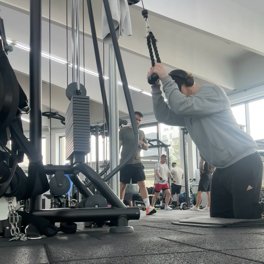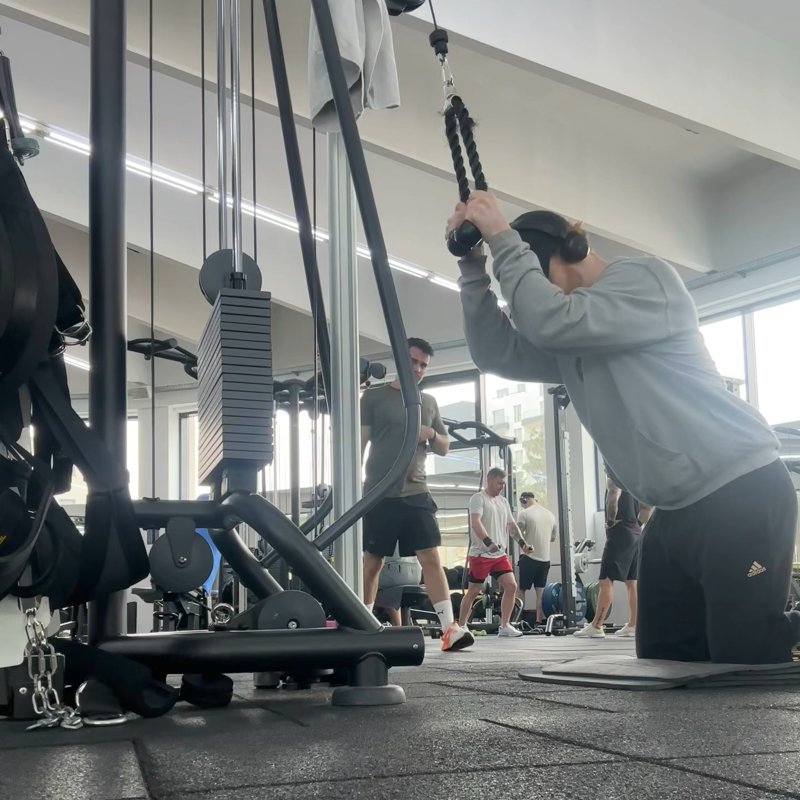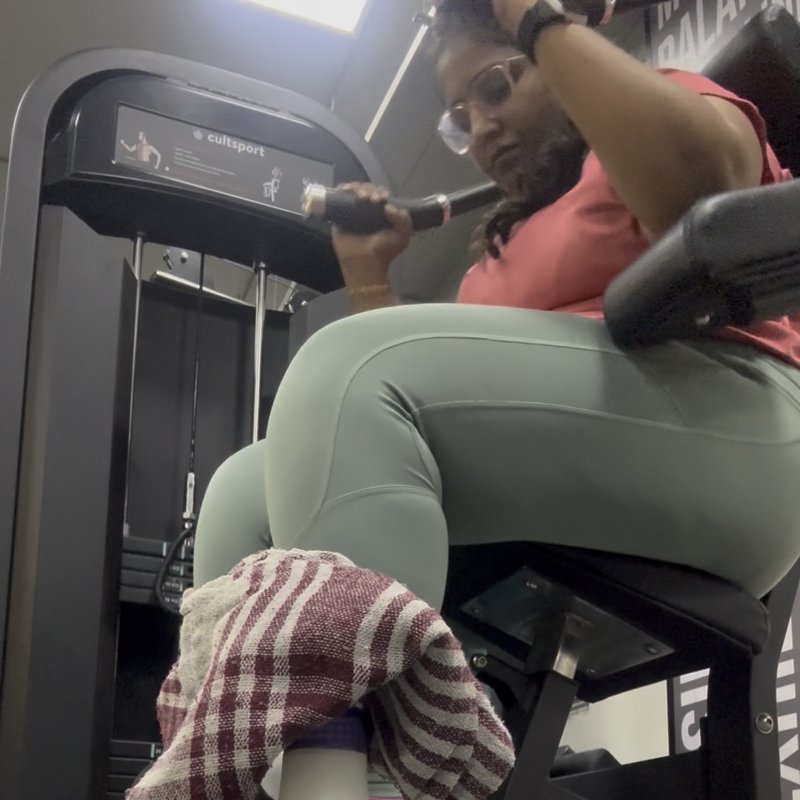Kneeling Cable Crunch: The Ultimate Guide
The Kneeling Cable Crunch is an isolation exercise that directly targets the rectus abdominis and obliques using cable resistance to create consistent tension throughout the movement for maximum abdominal development.

Quick Facts
Key Benefit
Targeted rectus abdominis development with consistent resistance
Primary Muscles
Obliques
Secondary Muscles
Erector Spinae, Hip Flexors, Pectoralis Minor
Equipment
cable machine
Difficulty
Intermediate
Type
Strength
In This Guide
Ready to master the Kneeling Cable Crunch?
Track your progress, see improvements over time, and build strength consistently.
Download GravitusThe Kneeling Cable Crunch stands as one of the most effective exercises for targeted abdominal development, offering advantages that many traditional ab exercises cannot match. This movement primarily targets the rectus abdominis—the "six-pack" muscle—while also engaging the obliques and other core stabilizers through a controlled flexion of the spine against consistent resistance. What distinguishes the cable crunch from conventional abdominal exercises is the constant tension provided by the cable throughout the entire range of motion. Unlike bodyweight movements where resistance varies based on leverage, the cable maintains consistent challenge from start to finish, maximizing muscle fiber recruitment and growth potential. The kneeling position creates an optimal angle for abdominal engagement while minimizing hip flexor involvement—a common issue with many ab exercises that can lead to lower back discomfort. Additionally, the cable apparatus allows for precise progressive overload through small, measurable weight increments, making it easier to track progress and continually challenge the muscles. Whether your goal is to develop defined abdominals, strengthen your core for improved athletic performance, or build foundational strength for other lifts, the Kneeling Cable Crunch delivers targeted stimulation in a joint-friendly manner that can be scaled to any fitness level.
Benefits of Kneeling Cable Crunch
The Kneeling Cable Crunch offers several unique advantages for abdominal development compared to traditional core exercises.
Constant Tension
The cable provides consistent resistance throughout the entire range of motion, eliminating the "resting" points common in bodyweight ab exercises.
Progressive Overload
Weight can be precisely adjusted in small increments, allowing for measurable progression that's difficult to achieve with bodyweight movements.
Reduced Hip Flexor Involvement
The kneeling position minimizes hip flexor activation, focusing work on the abdominals and reducing potential lower back strain.
Full Range of Motion
Allows for a complete stretch and contraction of the abdominal muscles, enhancing development compared to exercises with limited ranges.
Scalable Intensity
Suitable for various fitness levels as resistance can be adjusted from very light to extremely challenging to match individual capabilities.
Proper Form & Technique
Setup
- Attach a rope handle to a high pulley on a cable machine.
- Select an appropriate weight that challenges your abdominals while allowing proper form.
- Kneel on the floor or a padded mat facing the cable machine, approximately 1-2 feet away from the base.
- Grasp the rope with both hands, placing it behind your head at the base of your skull or lightly touching your traps.
- Position your hips at approximately 90 degrees, with thighs perpendicular to the floor.
- Begin with a slight forward lean from the hips to create initial tension on the abdominals.
- Keep your lower back in a neutral position, avoiding excessive arching or rounding.
Movement
- Initiate the movement by contracting your abdominals, flexing your spine, and drawing your rib cage toward your pelvis.
- Pull your torso downward and slightly forward in a curling motion, keeping the rope positioned at the back of your head.
- Maintain pressure between your hands and your head/neck area, but avoid pulling on your head or neck.
- Continue curling until your elbows approach your knees or thighs, maximizing abdominal contraction.
- Hold the contracted position briefly (1-2 seconds) to enhance mind-muscle connection.
- Slowly return to the starting position with control, allowing your spine to extend without overarching.
- Maintain tension on the abdominals throughout the entire movement, avoiding rest at the top position.
- Repeat for the desired number of repetitions, focusing on quality contractions rather than quantity.
Key Form Tips
Movement Focus
The motion should come from spinal flexion (rounding of the back), not from the hips or arms pulling the weight down.
Head Position
Keep your head in a neutral position aligned with your spine throughout the movement—neither tucked nor extended.
Cable Tension
Maintain constant tension on the cable throughout the exercise, never allowing the weight stack to rest between repetitions.
Breathing
Exhale during the contraction (downward phase) and inhale during the return to starting position.
Pelvic Position
Keep your hips relatively stationary throughout the exercise—the movement should occur through your spine, not your hips.
Muscles Worked
Primary Muscles
- Rectus Abdominis: The "six-pack" muscle running vertically along the front of the abdomen, which flexes the spine and compresses the abdominal contents.
- obliques: The muscles along the sides of the abdomen that assist in spinal flexion and rotation, contributing to comprehensive core development.
Secondary Muscles
- Transverse Abdominis: The deep core muscle that wraps around your spine and sides, acting as a natural weight belt to stabilize the spine and pelvis.
- pectoralis minor: The "boxer's muscle" along the lateral rib cage that assists in scapular stabilization during the movement.
- Hip Flexors: While not a primary target, the iliopsoas and rectus femoris receive moderate activation for stabilization during the exercise.
- erector spinae: The muscles along the spine work eccentrically during the lowering phase and help control the movement.
Common Mistakes and How to Fix Them
Pulling With the Arms
Using arm strength to pull the weight down rather than contracting the abdominals reduces effectiveness. Focus on keeping your arms relatively passive, serving only as a connection between the rope and your head/neck. The movement should be driven by abdominal contraction, not by pulling with the arms. Think of your hands as hooks and your arms as ropes—they transfer force but don't generate it. Practice the movement with lighter weight while concentrating on the sensation in your abdominals until proper form becomes habitual.
Moving From the Hips
Bending at the hips rather than flexing the spine turns this into more of a hip hinge than an abdominal exercise. Maintain a relatively stable hip position throughout the movement. The motion should come from rounding your spine (spinal flexion), not from folding at the hips. Imagine your pelvis is fixed in place while your ribcage moves toward it. If needed, place a rolled towel under your knees to help maintain proper positioning and focus on the curling motion of your torso rather than a forward fold.
Excessive Forward Lean
Starting with too much forward lean reduces the range of motion and decreases abdominal activation. Begin with only a slight forward lean to create initial tension. Your torso should start in a relatively upright position, allowing for a full range of motion during the crunch. If you find yourself leaning far forward at the starting position, you're likely compensating for weight that's too heavy or trying to use momentum. Reduce the weight and focus on proper positioning before progressing to heavier loads.
Jerking or Using Momentum
Using fast, ballistic movements to swing the weight down reduces muscle activation and increases injury risk. Control the movement throughout the entire range of motion, especially during the lowering (eccentric) phase. Use a moderate tempo—perhaps 2 seconds down, 1-second pause at the bottom, 2 seconds up—to eliminate momentum. Select a weight that allows for controlled movement rather than requiring momentum to complete the repetitions. Quality contractions are more valuable than moving heavy weight with poor form.
Pulling on the Head/Neck
Yanking on your head or neck to assist the movement can lead to strain and reduces abdominal engagement. The rope should maintain light contact with your head/neck area, but the force should be directed through your abdominals, not your cervical spine. Keep your neck in a neutral position throughout the movement, neither pulling it forward nor extending it back. If you find yourself pulling on your head, the weight is likely too heavy—reduce it until you can maintain proper form and focus on abdominal contraction.
Exercise Variations
Grip Variations
-

V-Bar Cable Crunch
Using a V-shaped bar attachment instead of rope, which some find provides more stability and comfort for the wrists.
-

Single-Handle Cable Crunch
Performing the movement with a single D-handle held at the back of the head for a slightly different feel and control pattern.
-

Wide-Grip Cable Crunch
Holding the ends of the rope wider apart to create a slightly different angle of resistance and muscle activation pattern.
Position Variations
-
Standing Cable Crunch
Performing the movement from a standing position, which increases the challenge to the core stabilizers and changes the angle of resistance.
-
Seated Cable Crunch
Executing the exercise while seated on a bench or stability ball, which provides back support while still allowing for effective abdominal contraction.
-

High-to-Low Cable Crunch
Kneeling at an angle to the cable to create a diagonal pulling pattern that can emphasize different portions of the abdominals.
Technical Variations
-

Rotational Cable Crunch
Adding a twisting motion during the contraction to increase oblique activation and mimic more functional movement patterns.
-
Pulse Cable Crunch
Performing small, pulsing repetitions at the point of maximum contraction to increase time under tension and metabolic stress.
-

Cable Crunch with Isometric Hold
Adding a 3-5 second isometric hold at the point of maximum contraction to enhance mind-muscle connection and stimulate deeper fibers.
Frequently Asked Questions
Most people achieve optimal results training abdominals 2-4 times per week, with the Kneeling Cable Crunch potentially included in some or all of these sessions. The abdominals, like other muscle groups, require both adequate stimulus and recovery time to develop. If you're performing high-intensity abdominal training with significant resistance, 2-3 weekly sessions may be sufficient. For those using moderate intensity, training 3-4 times weekly might be appropriate. Since the abdominals tend to recover relatively quickly compared to larger muscle groups, they can generally handle higher frequency training without overuse issues. However, this can vary based on individual recovery capacity and the intensity of your workouts. A sensible approach is to start with 2-3 sessions per week, monitor your recovery and progress, then adjust as needed. Many find success incorporating cable crunches in 2 weekly sessions while using different abdominal exercises in additional sessions to provide varied stimulus while preventing overuse of any single movement pattern.
Neither exercise is universally "better," but cable crunches offer several distinct advantages over traditional bodyweight crunches. The primary benefit of cable crunches is the constant tension they provide throughout the entire range of motion, whereas bodyweight crunches typically have reduced tension at certain points in the movement. Cable crunches also allow for precise progressive overload through incremental weight increases, which is more challenging to achieve with bodyweight exercises where resistance can only be modified through leverage or added weight. Additionally, the kneeling position of cable crunches often reduces hip flexor involvement compared to floor crunches, potentially decreasing lower back stress for some individuals. However, bodyweight crunches have their own advantages—they require no equipment, can be performed anywhere, and may be more accessible for beginners. For optimal development, consider including both types in your training program, perhaps using cable crunches for strength-focused work and bodyweight variations for higher-rep endurance training or when equipment isn't available.
The appropriate weight for cable crunches depends on your current strength level, training experience, and specific goals. Rather than focusing on a particular number, select a weight that allows you to maintain proper form while challenging your abdominals in your target repetition range. For muscle building (hypertrophy), most trainees find success in the 8-15 repetition range. This typically means using a weight that causes significant fatigue in the final few repetitions while still maintaining strict form. For more strength-oriented goals, you might work in the 6-10 repetition range with heavier weights. Beginners should start conservatively—often with 20-40 pounds (9-18 kg)—focusing first on mastering the movement pattern before adding substantial load. Intermediate lifters typically work with 40-70 pounds (18-32 kg), while advanced trainees might use 70-120+ pounds (32-54+ kg) depending on individual strength levels. Whatever weight you choose, the most important factors are: (1) maintaining proper form throughout each repetition, (2) feeling the work primarily in your abdominals rather than arms or hips, and (3) achieving progressive overload by gradually increasing the resistance as your strength improves.
Feeling cable crunches primarily in your hip flexors rather than your abdominals typically indicates a form issue. The most common cause is performing a hip flexion movement rather than true spinal flexion. When you bend at the hips instead of rounding your spine, you're essentially performing a hip hinge that heavily engages the hip flexors while minimizing abdominal activation. To correct this issue: First, ensure your hips remain relatively stationary throughout the movement—the action should come from your spine curling forward, not from your torso hinging at the hips. Second, focus on drawing your ribcage toward your pelvis rather than bringing your chest toward your knees. Imagine shortening the distance between your sternum and pubic bone by contracting your abdominals. Third, try starting with a more upright torso position rather than leaning too far forward, which can pre-activate the hip flexors. Fourth, consider using slightly less weight until you can establish the proper movement pattern and mind-muscle connection. Finally, incorporating a brief pause at the point of maximum contraction while consciously squeezing your abdominals can help reinforce proper muscle activation patterns. With practice and attention to these details, you should begin feeling the exercise primarily in your target muscles.
Video Demonstrations

Log in to watch video demonstrations
Login to Watch3 video demonstrations available
Track your progress with Gravitus
Download Gravitus to log your workouts, track your progress, and join a community of fitness enthusiasts.

Helpful Resources
One Rep Max Calculator
Find your one rep max for any exercise without maximal testing. Essential for developing effective strength training programs.
Calculate 1RMWorkout Programs
Follow structured workout programs created by fitness professionals to maximize your strength and muscle gains.
View Programs




